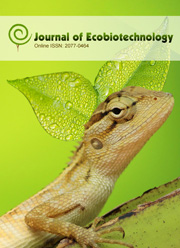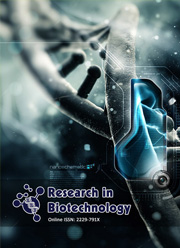Biological indicators to check water quality in plastic-heavy water bodies
DOI:
https://doi.org/10.25081/jebt.2022.v14.7290Keywords:
Bioindicator, Plastic, Water quality, EnvironmentAbstract
Water quality is a canonical group of physical, chemical, and biological properties of the given water. The environment and its compartments have been severely polluted by heavy metals and plastic waste. This has compromised the ability of the environment to foster life and render its intrinsic values. Human population increase and consistent demand for heavy metals and plastic products are responsible for the continuous increase in the production of plastic and heavy waste and its accompanied environmental pollution. Biological indicators help in indicating and monitoring the health of the environment. Here, an overview of recent achievements in checking water quality and water pollution trends has been summarized. Papers that reported environmental and public health effects related to plastic-heavy pollutants have also been reviewed. The research for this article intends to further facilitate the R&D initiatives of Jozbiz Technologies Pvt. Ltd.
Downloads
References
Anyanwu, B. O., Ezejiofor, A. N., Igweze, Z. N., & Orisakwe, O. E. (2018). Heavy Metal Mixture Exposure and Effects in Developing Nations: An Update. Toxics, 6(4), 65. https://doi.org/10.3390/toxics6040065
Avio, C. G., Gorbi, S., & Regoli, F. (2015). Experimental development of a new protocol for extraction and characterization of microplastics in fish tissues: First observations in commercial species from Adriatic Sea. Marine Environmental Research, 111, 18–26. https://doi.org/10.1016/j.marenvres.2015.06.014
Bamidele, A., & Kuton, M. P. (2016). Parasitic diseases and heavy metal analysis in Parachanna obscura (Gunther 1861) and Clarias gariepinus (Burchell 1901) from Epe Lagoon, Lagos, Nigeria. Asian Pacific Journal of Tropical Disease, 6(9), 685–690. https://doi.org/10.1016/S2222-1808(16)61110-6
Barnes, D. K., Galgani, F., Thompson, R. C., & Barlaz, M. (2009). Accumulation and fragmentation of plastic debris in global environments. Philosophical transactions of the Royal Society of London. Series B, Biological Sciences, 364(1526), 1985–1998. https://doi.org/10.1098/rstb.2008.0205
Bartell, S. M. (2006). Biomarkers, bioindicators, and ecological risk assessment a brief review and evaluation. Environmental Bioindicators, 1(1), 39-52. https://doi.org/10.1080/15555270591004920
Besseling, E., Wegner, A., Foekema, E. M., van den Heuvel-Greve, M. J., & Koelmans, A. A. (2013). Effects of microplastic on fitness and PCB bioaccumulation by the lugworm Arenicola marina (L.). Environmental Science & Technology, 47(1), 593–600. https://doi.org/10.1021/es302763x
Bolten, A. B., & Witherington, B. E. (2003). Loggerhead Sea Turtles (pp. 352) Washington, D.C.: Smithsonian Institution Scholarly Press.
Boyer, J. N., & Briceño, H.O. (2006). FY2005 Annual Report of the South Florida Coastal Water Quality Monitoring Network. SFWMD/SERC Cooperative Agreement #C-15397. SERC Tech. Rep. # T-326.
Boyer, J. N., & Keller, B. (2007). Nutrient dynamics. In J. H.Hunt, W. Nuttle, (Eds.), Florida Bay Science Program: A Synthesis of Research on Florida Bay (pp. 55–76). Florida Fish and Wildlife Conservation Commission.
Boyer, J. N., Kelble, C. R., Ortner, P. B., & Rudnick, D. T. (2009). Phytoplankton Bloom Status: Chlorophyll a Biomass as an Indicator of Water quality condition in the southern estuaries of Florida, USA. Ecological Indicators, 9(6), S56-S67. https://doi.org/10.1016/j.ecolind.2008.11.013
Browne, M. A., Dissanayake, A., Galloway, T. S., Lowe, D. M., & Thompson, R. C. (2008). Ingested microscopic plastic translocates to the circulatory system of the mussel, Mytilus edulis (L). Environmental Science & Technology, 42(13), 5026–5031. https://doi.org/10.1021/es800249a
Casale, P., & Marco, A. (2017). Caretta caretta (North East Atlantic subpopulation). Red List of Threatened Species. https://doi.org/10.2305/IUCN.UK.2017-2 RLTS.T3897A119333622.en
Casale, P., Abbate, G., Freggi, D., Conte, N., Oliverio, M., & Argano, R. (2008). Foraging ecology of loggerhead sea turtle Caretta caretta in the central Mediterranean Sea: evidence for a relaxed life history model. Marine Ecology Progress Series, 372, 265-276. https://doi.org/10.3354/meps07702
Cesar-Ribeiro, C., Rosa, H. C., Rocha, D. O., Dos Reis, C., Prado, T. S., Muniz, D., Carrasco, R., Silva, F. M., Martinelli-Filho, J. E., & Palanch-Hans, M. F. (2017). Light-stick: A problem of marine pollution in Brazil. Marine pollution bulletin, 117(1-2), 118–123. https://doi.org/10.1016/j.marpolbul.2017.01.055
Childers, D. L., Boyer, J. N., Davis, S. E., Madden, C. J., Rudnick, D. T., & Sklar, F. H., (2006). Nutrient concentration patterns in the oligotrophic ‘‘upside-down’’ estuaries of the Florida Everglades. Limnology and Oceanography, 51(1), 602–616.
China Ministry of Commerce. (2016). China Renewable Resources Recycling Industry Development Report. http://f.boolv.com/News/Image/20160811/201608110819469264.pdf
Cooper, D. R., Skelton, A. C. H., Moynihan, M. C., & Allwood, J. M. (2014). Component level strategies for exploiting the lifespan of steel in products. Resources, Conservation and Recycling, 84, 24–34. https://doi.org/10.1016/j.resconrec.2013.11.014
D'Costa, A., Shyama, S. K., Praveen Kumar, M. K. (2017). Bioaccumulation of trace metals and total petroleum and genotoxicity responses in an edible fish population as in dicators of marine pollution. Ecotoxicology and Environmental Safety, 142, 22-28. https://doi.org/10.1016/j.ecoenv.2017.03.049
Diamant, A. (1989). Ecology of the acanthocephalan Sclerocollum rubrimaris Schmidt and Paperna, 1978 (Rhadinorhynchidae: Gorgorhynchinae) from wild populations of rabbitfish (genus Siganus) in the northern Red Sea. Journal of Fish Biology, 34(3), 387–397. https://doi.org/10.1111/j.1095-8649.1989.tb03321.x
Donnelly-Greenan, E. L., Harvey, J. T., Nevins, H. M., Hester, M. M., & Walker, W. A. (2014). Prey and plastic ingestion of Pacific Northern Fulmars (Fulmarus glacialis rogersii) from Monterey Bay, California. Marine Pollution Bulletin, 85(1), 214–224. https://doi.org/10.1016/j.marpolbul.2014.05.046
Dris, R., Gasperi, J., Mirande, C., Mandin, C., Guerrouache, M., Langlois, V., & Tassin, B. (2016). A first overview of textile fibers, including microplastics, in indoor and outdoor environments. Environmental Pollution, 221, 453–458. https://doi.org/10.1016/j.envpol.2016.12.013
Dural, M., Göksu, M. Z., Ozak, A. A., & Derici, B. (2006). Bioaccumulation of some heavy metals in different tissues of Dicentrarchus labrax L, 1758, Sparus aurata L, 1758 and Mugil cephalus L, 1758 from the Camlik lagoon of the eastern coast of Mediterranean (Turkey). Environmental Monitoring and Assessment, 118(1-3), 65–74. https://doi.org/10.1007/s10661-006-0987-7
Farrell, P., & Nelson, K. (2013). Trophic level transfer of microplastic: Mytilus edulis (L.) to Carcinus maenas (L.). Environmental Pollution, 177, 1–3. https://doi.org/10.1016/j.envpol.2013.01.046
Fourqurean, J. W., & Robblee, M. B. (1999). Florida Bay: A history of recent ecological changes. Estuaries, 22(2B), 345–357. https://doi.org/10.2307/1353203
Fraga, N. S., Martins, A. S., Faust, D. R., Sakai, H., Bianchini, A., da Silva, C. C., & Aguirre, A. A. (2018). Cadmium in tissues of green turtles (Chelonia mydas): A global perspective for marine biota. The Science of the Total Environment, 637-638, 389–397. https://doi.org/10.1016/j.scitotenv.2018.04.317
Haggard, B. E., Scott, J. T., & Longing, S. D. (2013). Sestonic chlorophyll-a shows hierarchical structure and thresholds with nutrients across the Red River Basin, USA. Journal of Environmental Quality, 42(2), 437-445. https://doi.org/10.2134/jeq2012.0181
Hoarau, L., Ainley, L., Jean, C., & Ciccione, S. (2014). Ingestion and defecation of marine debris by loggerhead sea turtles, Caretta caretta, from by-catches in the South-West Indian Ocean. Marine Pollution Bulletin, 84(1-2), 90–96. https://doi.org/10.1016/j.marpolbul.2014.05.031
Hoornweg, D., & Bhada-Tata, P. (2012). What a Waste: A Global Review of Solid Waste Management, Urban Development Series Knowledge Papers, World Bank.
Hoornweg, D., Bhada-Tata, P., & Kennedy, C. (2013). Environment: Waste production must peak this century. Nature, 502(7473), 615–617. https://doi.org/10.1038/502615a
Jambeck, J. R., Geyer, R., Wilcox, C., Siegler, T. R., Perryman, M., Andrady, A., Narayan, R., & Law, K. L. (2015). Marine pollution. Plastic waste inputs from land into the ocean. Science, 347(6223), 768–771. https://doi.org/10.1126/science.1260352
Kühn, S., & van Franekeer, J. A. (2012). Plastic ingestion by the northern fulmar (Fulmarus glacialis) in Iceland. Marine Pollution Bulletin, 64(6), 1252-1254. https://doi.org/10.1016/j.marpolbul.2012.02.027
Malek, M., Haseli, M., Mobedi, I., Ganjali, M. R., & Mackenzie, K. (2007). Parasites as heavy metal bioindicators in the shark Carcharhinus dussumieri from the Persian Gulf. Parasitology, 134(7), 1053–1056. https://doi.org/10.1017/S0031182007002508
Mirghaed, A. T., Hoseini, S. M., & Ghelichpour, M. (2018). Effects of dietary 1, 8-cineole supplementation on physiological, immunological and antioxidant responses to crowding stress in rainbow trout (Oncorhynchus mykiss). Fish & Shellfish Immunology, 81, 182–188. https://doi.org/10.1016/j.fsi.2018.07.027
MSFD-TS Marine Litter. (2013). Georg Hanke, François Galgani, Werner, Stefanie, Oosterbaan, Lex, Nilsson, 2013. Guidance on Monitoring of Marine Litter in European Seas. EUR 26113. Publications Office of the European Union, Luxembourg.
Norouzi, E., Bahramifar, N., & Ghasempouri, S. M. (2012). Effect of teeth amalgam on mercury levels in the colostrums human milk in Lenjan. Environmental monitoring and assessment, 184(1), 375–380. https://doi.org/10.1007/s10661-011-1974-1
Olmedo, P., Pla, A., Hernández, A. F., Barbier, F., Ayouni, L., & Gil F. (2013). Determination of toxic elements (mercury, cadmium, lead, tin and arsenic) in fish and shellfish samples. Risk assessment for the consumers. Environment International, 59, 63–72. https://doi.org/10.1016/j.envint.2013.05.005
Plastemart. (2005). China leads in growth of polymers & plastic products. www.plastemart.com/upload/Literature/chineseplasticandpolymergrowth.asp
Plastics Europe. (2006). The Compelling Facts About Plastics: An Analysis of Plastic Production, Demand and Recovery for 2006 in Europe. https://plasticseurope.org/wp-content/uploads/2021/10/2006-Compelling-facts.pdf
Rillig, M. C. (2012). Microplastic in terrestrial ecosystems and the soil? Environmental Science & Technology, 46(12), 6453–6454. https://doi.org/10.1021/es302011r
Rochman, C. M., Browne, M. A., Underwood, A. J., van Franeker, J. A., Thompson, R. C., & Amaral-Zettler, L. A. (2016). The ecological impacts of marine debris: unraveling the demonstrated evidence from what is perceived. Ecology, 97(2), 302–312. https://doi.org/10.1890/14-2070.1
Rudnick, D. T., Ortner, P. B., Browder, J. A., & Davis, S. M. (2005). A conceptual ecological model of Florida Bay. Wetlands, 25(4), 870–883. https://doi.org/10.1672/0277-5212(2005)025[0870:ACEMOF]2.0.CO;2
Schmidt, C., Krauth, T., & Wagner, S. (2017). Export of Plastic Debris by Rivers into the Sea. Environmental Science & Technology, 51(21), 12246–12253. https://doi.org/10.1021/acs.est.7b02368
Sures, B. (2001). The use of fish parasites as bioindicators of heavy metals in aquatic ecosystems: A review. Aquatic Ecology, 35, 245–255.
Sures, B., Nachev, M., Selbach, C., & Marcogliese, D. J. (2017). Parasite responses to pollution: What we know and where we go in ‘Environmental Parasitology’. Parasites & Vectors, 10, 65.
U.S. Environmental Protection Agency. (2013). Municipal Solid Waste in the Unites States: 2011 Facts and Figures (EPA530-R-13-001, U.S. EPA, 2013).
van Franeker, J. A., & Law, K. L. (2015). Seabirds, gyres and global trends in plastic pollution. Environmental Pollution, 203, 89-96. https://doi.org/10.1016/j.envpol.2015.02.034
Vardanyan, L., Schmieder, K., Sayadyan, H., Heege, T., Heblinski, J., & Agyemang, T. (2007). Heavy metal accumulation by certain aquatic macrophytes from Lake Sevan (Armenia). In M. Sengupta & R. Dalwani, (Eds.), Proceedings of Taal 2007, the 12th World Lake Conference (pp.1020-1038), Ministry of Environment and Forests, Government of India: New Delhi, India, 2008.
Viñas, L., Pérez-Fernández, B., Soriano, J. A., López, M., Bargiela, J., & Alves, I. (2018). Limpet (Patella sp) as a biomonitor for organic pollutants. A proxy for mussel?. Marine Pollution Bulletin, 133, 271–280. https://doi.org/10.1016/j.marpolbul.2018.05.046
von Moos, N., Burkhardt-Holm, P., & Khöler, A. (2012). Uptake and effects of microplastics on cells and tissue of the blue mussel Mytilus edulis L. after an experimental exposure. Environmental Science and Technology, 46(20), 11327-11335. https://doi.org/10.1021/es302332w
Wagner, M., Scherer, C., Alvarez-Muñoz, D., Brennholt, N., Bourrain, X., Buchinger, S., Fries, E., Grosbois, C., Klasmeier, J., Marti, T., Rodriguez-Mozaz, S., Urbatzka, R., Vethaak, A. D., Winther-Nielsen, M., & Reifferscheid, G. (2014). Microplastics in freshwater ecosystems: what we know and what we need to know. Environmental Sciences Europe, 26(1), 12. https://doi.org/10.1186/s12302-014-0012-7
Wilson, D. C. (2015). Global Waste Management Outlook, International Solid Waste Association and United National Environment Programme.
Zhan-feng, M., & Bing, Z. (2009). China plastics recycling industry in 2008. China Plastics, 23, 7.
Published
How to Cite
Issue
Section
Copyright (c) 2022 Anukul Rudkiwal

This work is licensed under a Creative Commons Attribution-NonCommercial 4.0 International License.



 .
.